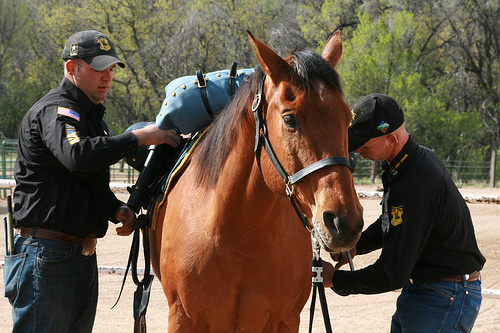In general, horse riding is one of those risk sports and there are obvious dangers that we fall off when riding a horse. For this reason, any horse rider typically treats their horses with respect to allow better handling in the stable and on the ground. Horse riding shouldn’t be more dangerous than other sport if we understand some typical precautions. There are a number of horse riding safety tips that we need to consider. As herbivores, horses are also prey animals and they have defensive tendency when facing potential threats. They will try to protect themselves when facing something that they don’t understand. For this reason, people who stand behind the horse could be in greater risk of being kicked. Like people, each horse could have very different character and some can even bite, this could happen when horses are typically given carrot and if they’re in a particularly bad mood. It is important to keep kids under control whenever possible. It should be noted that stables and the riding grounds are not place for children to play.
It is essential to wear riding helmets all the time and it is considered as a paramount safety component in any horse riding activity. In fact, we should wear helmets when handling the horse, even if we don’t plan to ride it. There are different designs of riding hats, some can be better suited for our heads, but others don’t. Hats can’t prevent all kinds of injury, but they could still protect our skull against sudden impact from falls and kicks. Damaged helmet that have hit a hard surface should be replaced immediately. Good riding hats should be available for about $50, but more expensive and stronger models can be higher than $100.
Safety in horse riding could also be enhanced with specific body protector that give us some amount of protection to the back and chest area. It could protect us when we fall onto solid surface or if the horse accidentally stands on us after we fall. Body protectors should be strong enough to prevent serious or fatal injury on the torso. There are three levels of protection:
- Black labels: Appropriate for licensed jockeys and provide basic level of protection.
- Brown label: Provide moderate protection and can be appropriate for typical low-risk situations, which don’t include riders with less experience, riding more excitable horses, jumping over obstacles and riding faster on hard surfaces.
- Purple label: Provide adequate protection for any horse riding activity, including competitions and jumping over obstacles. It can prevent rib fractures and soft tissue injuries.
Body protector could feel rather restrictive and strange for new horse riders, so we should make sure that our protectors is appropriate for our body shape. The protector should also be convenient to use in both cold and warm weather. In any case, we should persevere with wearing a protector, even if we are uncomfortable with it. In fact, more experienced horse riders feel like that they are naked when riding without adequate body protector.

